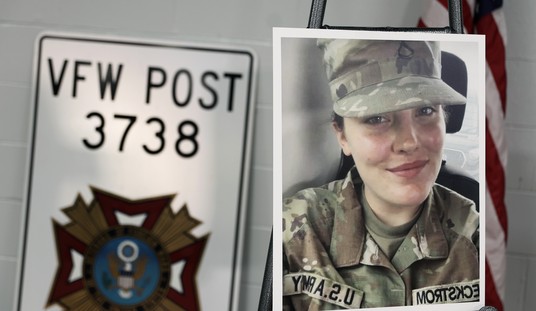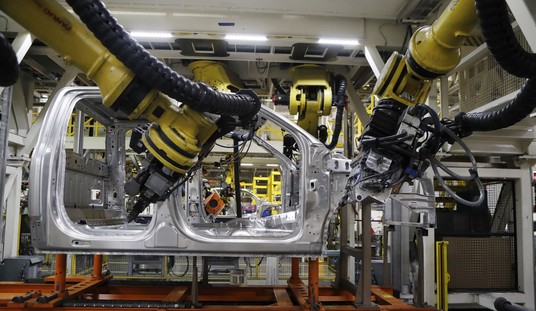The history of mankind is the history of weaponry. From the first simple flint hand-axe to today's modern super-carriers, much of human technological progress has been driven by weaponry, be it for hunting or warfare. Weapons are, in large part, what makes us what we are. Other animals have speed, strength, horns, hooves, fangs, and claws. By comparison, we're pretty soft and squishy, as large mammals go, but we have brains, and those brains enable us to make weapons. That, early on, put us on a par with even the largest predators; a smart lion would think twice before attacking three or four grown men armed with spears.
Throughout history, some weapons have made a huge difference. One example is the battleship, which was the basis for every major navy in the late 19th century through World War 2. Earlier today (Tuesday), I engaged in some speculation about the value such a ship might have even today.
See Also: New Chief of Naval Operations Wants Inexpensive Ways to Hit Houthis, and I Have Some Thoughts
There are ten major weapons, though, that through history have dealt major changes in land warfare. Here's that list.
- Atlatl (spear-thrower): This was a simple device that allowed the user to cast a spear or a heavy dart farther and faster than one could by hand. It was the first step in a long line of innovations that allowed a person to strike a target at distance; the first ranged weapon that didn't rely solely on the user's arm, but applied a basic principle: Leverage.
- Bow and arrow: There are signs that the use of the bow and arrow goes back as far as 70,000 years. The bow evolved a great deal through that time, becoming through the centuries the heavy, laminated Roman bow, the English longbow, and the recurved bow - and today the high-tech compound bow.
- Catapults: This is more of a category than a weapon, ranging from the onager to the tension catapult to the trebuchet. The catapult allowed not only striking at range, but striking at range with a large, heavy projectile that no one person could wield. These were, in fact, the first crew-served weapons.
- Gunpowder (cannon): The first use of gunpowder in anything that could be called a "gun" was in the first cannons. Initially, they fired stone projectiles, and their advent on the field of battle spelled the end of walled cities; an enemy with cannon could batter down the walls. The Ottoman Turks took Constantinople in this way, battering down walls that had stood for hundreds of years and were more than 40 feet thick in places, but the Turkish cannons battered them down in 55 days.
- Gunpowder (small arms): Now ranged firepower, powered by gunpowder, could be in the hands of every common soldier. Beginning with the arquebus and later matchlock, wheellock, and flintlock muskets, the individual soldier's weapons allowed for volley fire. This ushered in an era where battle could be conducted at a distance.
- Repeating rifles/machine guns: The practical, military repeating rifle made its advent with the invention of fulminate primers and brass or copper cartridges; that happened in the early 19th century. In our Civil War, the Confederates bemoaned the Union Army's use of the Spencer and Henry repeaters by noting that the "Yankees can load on Sunday and shoot at us all week." Before the Great War, the advent of the machine gun made some hopeful that here, at last, was a weapon that would make warfare so horrible that it would finally become obsolete. But somehow, warfare survived both of those innovations and another:
- Aircraft: The United States' first use of aircraft in warfare was during Blackjack Pershing's punitive expedition into Mexico to search for the bandit leader Pancho Villa. Those aircraft belonged to the Signal Corps and were used for observation, as were aircraft in the opening months of the Great War. But by 1918, the sky was filled with bombers and pursuit planes, later called fighters - and that would set the stage for all air war to come.
- Chemical weapons: The Great War also saw the widespread use of chemical weapons, including chlorine and mustard gas. These were truly horrible, indiscriminate, killing not only people but everything, even the rats in the trenches. These were, in every sense of the word, weapons of mass destruction. But only a few decades later, the concept of weapons of mass destruction got a boost:
- Nuclear weapons: Developed and first used by the United States to end the Pacific war with Japan, nuclear weapons have come a long way since 1945. They have been developed to be far more powerful, from fission to fusion bombs, and more versatile. The United States developed an atomic howitzer and even an atomic bazooka, which set nuclear release authority down to two E-4s in a Jeep. The one thing every civilized power agrees on about nuclear weapons is that nobody wants to see them used. Speaking of which:
- Biological weapons: These scare me more than all the others combined. Biological weapons can be lethal, and they are self-spreading; they replicate, they move from host to host, and modern gene-editing technology makes the possibilities of what can be done with bioweapons truly terrifying. When a nuke goes off, the worst is over; but bugs reproduce, and they spread themselves. It's a whole new ball game.
And then, there's one more, a new system that may have wide-ranging potential as a weapon: Artificial intelligence.
See Also: Bill Gates Makes Big Claims on Artificial Intelligence - but There's a Problem
Now, AI cannot create, and it cannot innovate, but within its restraints, it can use algorithms in the place of decision-making to choose actions and take them within milliseconds, far, far faster than any human reaction. AI-equipped drones carrying smart weapons or even AI-equipped "brilliant" weapons could make asymmetrical warfare far more symmetrical. Russia and China are rumored to be researching how best to integrate AI into military weaponry, and if we are to even understand what that may end up looking like, we had better be doing the same thing here in the United States, because even if they don't engage the U.S. directly, we shouldn't be surprised if Russia and China deliver AI-augmented weapons to their proxies - like Iran.
We surely do live in interesting times. The history of weaponry is the history of humanity. And it's hard to see what might be coming next. Maybe AI will be the weapon that really does make war so horrible that it becomes obsolete, but I'm more inclined to agree with George Santayana: Only the dead have seen the end of war.














